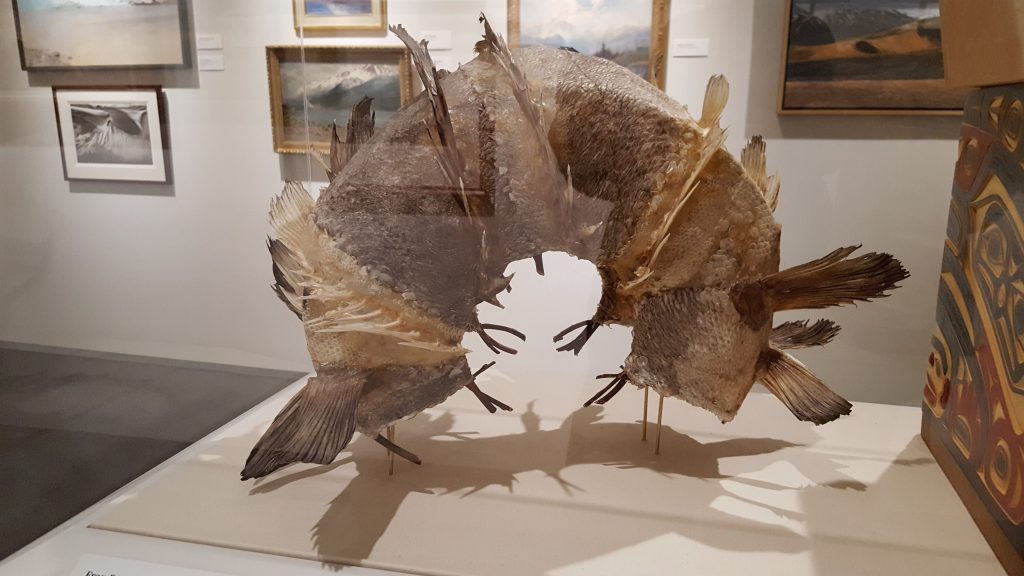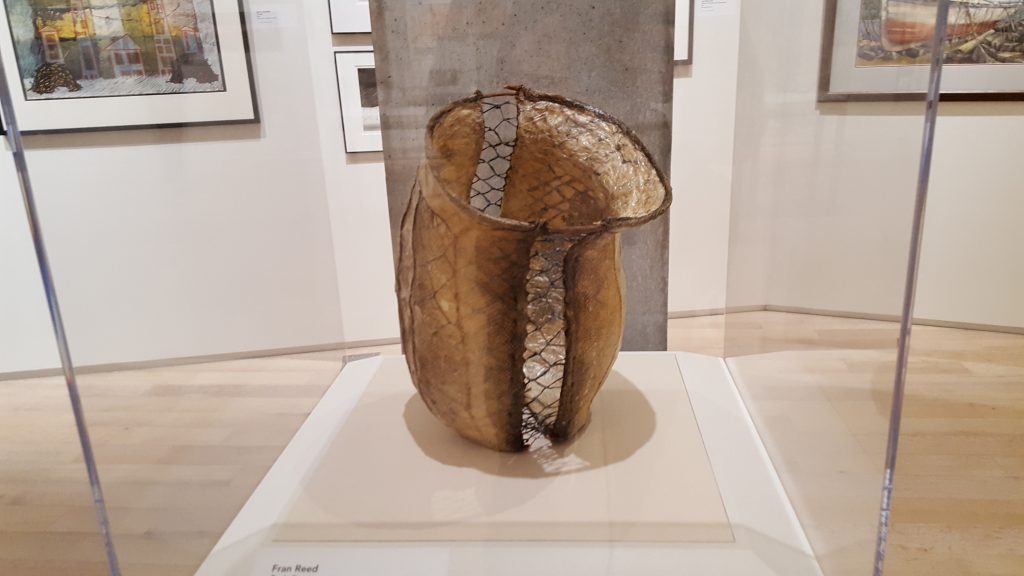Culturally Responsive Teaching
What is CRT?
Culturally Responsive Teaching is more than creating little lessons that showcase culture. Its more in depth than presenting music, dance, geography, etc. Its about sharing how people think about things, and using that thought process to solve problems. This makes a lesson about more than just “answer this question.” Its about connecting culture to learning.
MJ
Katie Kroko and I had the joy of chatting with MJ – one of the students at the Goldbelt Heritage Institute culture camp at Eagle River Methodist Camp. We all stumbled through the first few minutes of conversation, but once she started showing us around the camp, the power of culturally responsive teaching began to shine through. We arrived at the smokehouse, where the students had smoked porcupine, seal, and salmon. MJ talked about how awesome it was to be outdoors in the camp and get hands on with the tradition. Again and again she kept saying how she hoped she could share the food they had prepared with us – even though we were just visitors and hadn’t been apart of the preparation process.
It was humbling and warming – it put a smile on my face. She was that open to offer us something meaningful so quickly. We got to chat with her more – we asked her about the language and her heritage. She was only part Tlin’git, and expressed she was glad she was able to participate in the camp. She said that the opportunities to learn the language, songs, and dances inspired her to hopefully keep teaching the language, too. We were both excited to hear this. She had many wonderful things to say about the value of preserving culture and sharing it with a new generation. It was clear to me the hands-on intensive culture camp had matured her view of the world in ways other experiences may not have.
She also taught us the flowers of the wild rice smell like poo :O
Culturally Responsive Music Teaching
This is incredibly important as a music teacher – without Culturally Responsive teaching, you can’t teach music. Even the most abrasive, unkind, and dry music teacher will still point out the scotch snap or Neapolitan chord in the music, and explain how import that is to that music’s cultural heritage.
I feel I’ve already done culturally responsive teaching in music. Two years ago I focused on the story of Muddy Waters and the history of the blues. I taught this to my cello/bass students at the Youth Orchestra of Northern Alberta. It gave me a chance to talk about racism, segregation, and spiritual music – it connected to my students in a way that the classical music we had previously learned couldn’t. Another valuable thing the blues allowed me to do in the classroom was to truly teach self expression – once the kids had the fundamental pitches of the blues scale down, they could improvise their own solos as we explored the blues! The class had several students with behavior problems, and the blues increased the challenge to know the notes to perform, but eased the rules so they could be themselves. They didn’t have to feel defensive or afraid to participate.
I also like listening to music in my classes – I try to draw upon a wide variety of musics from all around the world. I always make sure the kids get to learn something about that music before we move on in class. Often, I try to tie that music into the lesson.
I feel its very easy to purvey culture in music education, buts its also very easy to just showcase an ethic composition and slap a gold star on your chest and feel proud. Really, you have to teach about the culture and the history – the students need context to understand that music and why its important that they play it!
—————————————————————————————
CRT Update!!!
Michelle and the Full Story
First, I really like Michelle’s lesson on the Aleutian Islands in World War II. IF it was mentioned in my public school history classes (I don’t remember it being mentioned) it was probably boiled down to a fact to memorize, wherein it happened and would be on a test. What I do remember is watching a documentary about the invasion of islands on the History Channel. Luckily I was a teen when the History Channel was still a quality source for documentaries, because I learned about the fascinating lead-up, logistics, and conflicts which played out on the islands.
After Michelle’s lesson, I realized I never learned the whole story. Even that documentary mentioned nothing about the capture of Aleut peoples by the Japanese, nor the systemic discrimination and domineering of the Aleuts by the Americans. It was haunting to learn about the relocation of the families with the likely intent of keeping them essentially in the role of slaves. It was disturbing to know families were torn apart on purpose, and kept in a place unfit for living.
Teaching the whole story – even when its unpleasant and disturbing – is incredibly important. The status quo will remain with the heroic “USA v. Japan” story of the war unless we teach the whole story. If the Japanese are always the enemy mistreating POWs, and raping civilians in Manchuria while the USA is liberating islands and saving lives – we are sustaining a story about racism. We are placing all of the violence and horrible acts upon the Japanese when the truth is our country performed many atrocities during WWII also; the Japanese relocation and internment, and the manipulation and exploitation of the Aleut. By ignoring these stories in our schools and texts, we are enforcing national discrimination and racism and calling it education. It seems subtle – we are just telling a story of nationalism and patriotism – but its not. Secretly, the sludge creeps its way out of the box – the dirty truth is there, we cannot abide ignorance.
The Full Story … has Pictures!
And now for something completely different. I enjoyed the challenge of finding ways to make multicultural picture books relevant to a music classroom. Thanks, Kathy! I really enjoyed the story, “Secret of the Dance”, because it resonated with so much of what I’ve learned from studying the Yup’ik and Inupiaq for the iBook lesson plans. The view of that magical moment of the dance posed before the true loss of culture was deep and sorrowful. Reading about living people who know so little about their thousands of years of history because of 200 years of Westernization is disheartening. To think how insensitive and corrupt the American generations before us were to so harshly destroy the rich heritage of other human beings…
Saying it Like it Is
I loved Ernestine’s presentation of her book Blonde Indian. Her way of speaking was so closely tied to the poetry of her writings. It was enthralled while listening to her. Her words were so powerful, I daresay those words bore a similar weight of wisdom and emotion akin to an Elder’s. I was fascinated to learn how she writes her books from multiple streams of narrative – fiction, memoir, nature, etc. – and then weaves them into a seamless multi-faceted whole. I loved her analysis of the (essentially) flippant Princess and the Pea fairy tail and the hilarious (but eye-opening) analysis of Dick, Jane, and Spot as a racist tome.
Most important to me though was hear fearlessness to say it as it is. To hear her flat out state the reality that Alaska as a state, despite its outward statements about making progress, is failing its native people. The schools – now 36 years after the Molly Hooch Rural School decision (sorry, just started learning about that part of AK history…) still isn’t providing adequate education to most of its peoples. In class we are learning about and from teachers who are doing it right, but the statistics still show Native students are not succeeding. It was so powerful to hear Ernestine say it straight, things have to change now, because things are only marginally better than they used to be.
Also, I know what book I’m reading next. I also know sometimes I may be weighty in these blog posts considering I don’t come from Alaska, nor have I experienced discrimination in the ways others have. I do, deep inside, believe in education as a medium for social justice. I have worked towards it in the classes I have taught in the past few years, and know it is a core value to how I build lessons and approach the conveyance of information. Often, Whites and others of privelidges see themselves as saviors of the impoverished, the discriminated, and the kicked around. Ernestine’s words resonated with me and my mission as a musician and an educator – We are not here to save them, we are here to believe in them.


